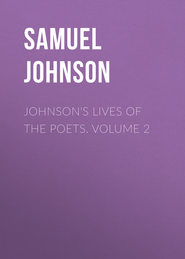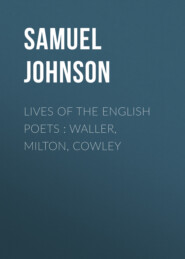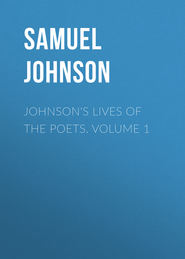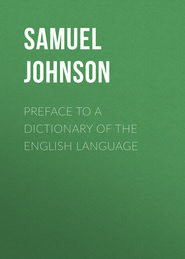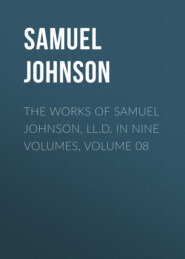По всем вопросам обращайтесь на: info@litportal.ru
(©) 2003-2025.
✖
The Works of Samuel Johnson, LL.D. in Eleven Volumes, Volume 06
Настройки чтения
Размер шрифта
Высота строк
Поля
In the next part, the authenticity of the letters is examined; and it seems to be proved, beyond contradiction, that the French letters, supposed to have been written by Mary, are translated from the Scotch copy, and, if originals, which it was so much the interest of such numbers to preserve, are wanting, it is much more likely that they never existed, than that they have been lost.
The arguments used by Dr. Robertson, to prove the genuineness of the letters, are next examined. Robertson makes use, principally, of what he calls the internal evidence, which, amounting, at most, to conjecture, is opposed by conjecture equally probable.
In examining the confession of Nicholas Hubert, or French Paris, this new apologist of Mary seems to gain ground upon her accuser. Paris is mentioned, in the letters, as the bearer of them to Bothwell; when the rest of Bothwell's servants were executed, clearing the queen in the last moment, Paris, instead of suffering his trial, with the rest, at Edinburgh, was conveyed to St. Andrew's, where Murray was absolute; put into a dungeon of Murray's citadel; and, two years after, condemned by Murray himself, nobody knew how. Several months after his death, a confession in his name, without the regular testifications, was sent to Cecil, at what exact time, nobody can tell.
Of this confession, Leslie, bishop of Ross, openly denied the genuineness, in a book printed at London, and suppressed by Elizabeth; and another historian of that time declares, that Paris died without any confession; and the confession itself was never shown to Mary, or to Mary's commissioners. The author makes this reflection:
"From the violent presumptions that arise from their carrying this poor ignorant stranger from Edinburgh, the ordinary seat of justice; their keeping him hid from all the world, in a remote dungeon, and not producing him, with their other evidences, so as he might have been publickly questioned; the positive and direct testimony of the author of Crawfurd's manuscript, then living, and on the spot at the time; with the publick affirmation of the bishop of Ross, at the time of Paris's death, that he had vindicated the queen with his dying breath; the behaviour of Murray, Morton, Buchanan, and even of Hay, the attester of this pretended confession, on that occasion; their close and reserved silence, at the time when they must have had this confession of Paris in their pocket; and their publishing every other circumstance that could tend to blacken the queen, and yet omitting this confession, the only direct evidence of her supposed guilt; all this duly and dispassionately considered, I think, one may safely conclude, that it was judged not fit to expose, so soon, to light this piece of evidence against the queen; which a cloud of witnesses, living, and present at Paris's execution, would, surely, have given clear testimony against, as a notorious imposture."
Mr. Hume, indeed, observes: "It is in vain, at present, to seek for improbabilities in Nicholas Hubert's dying confession, and to magnify the smallest difficulties into a contradiction. It was certainly a regular judicial paper, given in regularly and judicially, and ought to have been canvassed at the time, if the persons, whom it concerned, had been assured of their innocence." To which our author makes a reply, which cannot be shortened without weakening it:
"Upon what does this author ground his sentence? Upon two very plain reasons, first, that the confession was a judicial one, that is, taken in presence, or by authority of a judge. And secondly, that it was regularly and judicially given in; that must be understood during the time of the conferences before queen Elizabeth and her council, in presence of Mary's commissioners; at which time she ought to have canvassed it," says our author, "if she knew her innocence.
"That it was not a judicial confession, is evident: the paper itself does not bear any such mark; nor does it mention, that it was taken in presence of any person, or by any authority whatsoever; and, by comparing it with the judicial examinations of Dalgleish, Hay, and Hepburn, it is apparent, that it is destitute of every formality, requisite in a judicial evidence. In what dark corner, then, this strange production was generated, our author may endeavour to find out, if he can.
"As to his second assertion, that it was regularly and judicially given in, and, therefore, ought to have been canvassed, by Mary during the conferences; we have already seen, that this, likewise, is not fact: the conferences broke up in February, 1569: Nicholas Hubert was not hanged till August thereafter, and his dying confession, as Mr. Hume calls it, is only dated the 10th of that month. How, then, can this gentleman gravely tell us, that this confession was judicially given in, and ought to have been, at that very time, canvassed by queen Mary and her commissioners? Such positive assertions, apparently contrary to fact, are unworthy the character of an historian, and may, very justly, render his decision, with respect to evidences of a higher nature, very dubious. In answer, then, to Mr. Hume: As the queen's accusers did not choose to produce this material witness, Paris, whom they had alive and in their hands, nor any declaration or confession, from him, at the critical and proper time for having it canvassed by the queen, I apprehend our author's conclusion may fairly be used against himself; that it is in vain, at present, to support the improbabilities and absurdities in a confession, taken in a clandestine way, nobody knows how, and produced, after Paris's death, by nobody knows whom, and, from every appearance, destitute of every formality, requisite and common to such sort of evidence: for these reasons, I am under no sort of hesitation to give sentence against Nicholas Hubert's confession, as a gross imposture and forgery."
The state of the evidence relating to the letters is this:
Morton affirms, that they were taken in the hands of Dalgleish. Hie examination of Dalgleish is still extant, and he appears never to have been once interrogated concerning the letters.
Morton and Murray affirm, that they were written by the queen's hand; they were carefully concealed from Mary and her commissioners, and were never collated by one man, who could desire to disprove them.
Several of the incidents mentioned in the letters are confirmed by the oath of Crawfurd, one of Lennox's defendants, and some of the incidents are so minute, as that they could scarcely be thought on by a forger. Crawfurd's testimony is not without suspicion. Whoever practises forgery, endeavours to make truth the vehicle of falsehood.
Of a prince's life very minute incidents are known; and if any are too slight to be remarked, they may be safely feigned, for they are, likewise, too slight to be contradicted. But there are still more reasons for doubting the genuineness of these letters. They had no date of time or place, no seal, no direction, no superscription.
The only evidences that could prove their authenticity were Dalgleish and Paris; of which Dalgleish, at his trial, was never questioned about them; Paris was never publickly tried, though he was kept alive through the time of the conference.
The servants of Bothwell, who were put to death for the king's murder, cleared Mary with their last words.
The letters were first declared to be subscribed, and were then produced without subscription.
They were shown, during the conferences at York, privately, to the English commissioners, but were concealed from the commissioners of Mary.
Mary always solicited the perusal of these letters, and was always denied it.
She demanded to be heard, in person, by Elizabeth, before the nobles of England and the ambassadours of other princes, and was refused.
When Mary persisted in demanding copies of the letters, her commissioners were dismissed with their box to Scotland, and the letters were seen no more.
The French letters, which, for almost two centuries, have been considered as originals, by the enemies of Mary's memory, are now discovered to be forgeries, and acknowledged to be translations, and, perhaps, French translations of a Latin translation. And the modern accusers of Mary are forced to infer, from these letters, which now exist, that other letters existed formerly, which have been lost, in spite of curiosity, malice, and interest.
The rest of this treatise is employed in an endeavour to prove, that Mary's accusers were the murderers of Darnly: through this inquiry it is hot necessary to follow him; only let it be observed, that, if these letters were forged by them, they may easily be thought capable of other crimes. That the letters were forged, is now made so probable, that, perhaps, they will never more be cited as testimonies.
MARMOR NORFOLCIENSE:
Or, an essay on an ancient prophetical inscription, in monkish rhyme, lately discovered near Lynn, in Norfolk. By Probus Britannicus [17 - First printed in the year 1739.].
In Norfolk, near the town of Lynn, in a field, which an ancient tradition of the country affirms to have been once a deep lake, or meer, and which appears, from authentick records, to have been called, about two hundred years ago, Palus, or the marsh, was discovered, not long since, a large square stone, which is found, upon an exact inspection, to be a kind of coarse marble of a substance not firm enough to admit of being polished, yet harder than our common quarries afford, and not easily susceptible of injuries from weather or outward accidents.
It was brought to light by a farmer, who, observing his plough obstructed by something, through which the share could not make its way, ordered his servants to remove it. This was not effected without some difficulty, the stone being three feet four inches deep, and four feet square in the superficies; and, consequently, of a weight not easily manageable. However, by the application of levers, it was, at length, raised, and conveyed to a corner of the field, where it lay, for some months, entirely unregarded; nor, perhaps, had we ever been made acquainted with this venerable relick of antiquity, had not our good fortune been greater than our curiosity.
A gentleman, well known to the learned world, and distinguished by the patronage of the Maecenas of Norfolk, whose name, was I permitted to mention it, would excite the attention of my reader, and add no small authority to my conjectures, observing, as he was walking that way, that the clouds began to gather, and threaten him with a shower, had recourse, for shelter, to the trees under which this stone happened to lie, and sat down upon it, in expectation of fair weather. At length he began to amuse himself, in his confinement, by clearing the earth from his seat with the point of his cane; and had continued this employment some time, when he observed several traces of letters, antique and irregular, which, by being very deeply engraven, were still easily distinguishable.
This discovery so far raised his curiosity, that, going home immediately, he procured an instrument proper for cutting out the clay, that filled up the spaces of the letters; and, with very little labour, made the inscription legible, which is here exhibited to the publick:
POST-GENITIS
Cum lapidem hunc, magni
Qui nunc jacet incola stagni,
Vel pede equus tanget,
Vel arator vomere franget,
Sentiet aegra metus,
Effundet patria fletus,
Littoraque ut fluctu,
Resonabunt oppida luctu:
Nam foecunda rubri
Serpent per prata colubri,
Gramina vastantes,
Flores fructusque vorantes.
Omnia foedantes,
Vitiantes, et spoliantes;
Quanquam haud pugnaces,
Ibunt per cuncta minaces,
Fures absque timore,
Et pingues absque labore.
Horrida dementes
Rapiet discordia gentes;
Plurima tunc leges
Mutabit, plurima reges
Natio; conversa
In rabiem tunc contremet ursa
MARMOR NORFOLCIENSE
Cynthia, tunc latis
Florebunt lilia pratis;
Nec fremere audebit
Leo, sed violare timebit,
Omnia consuetus
Populari pascua lætus.
Ante oculos natos
Calceatos et cruciatos
Jam feret ignavus,
Vetitaque libidine pravus.
En quoque quod mirum,
Quod dicas denique dirum,






